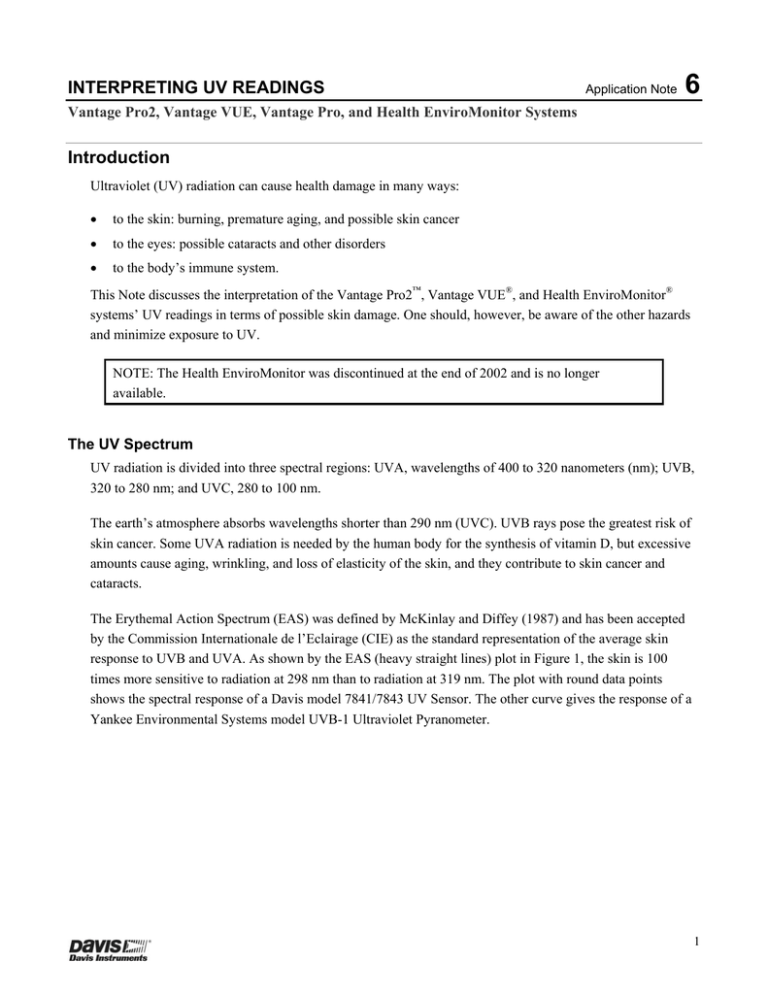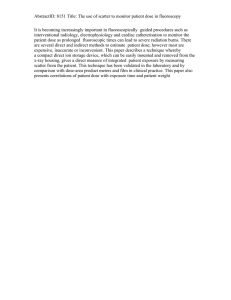
INTERPRETING UV READINGS
Application Note
6
Vantage Pro2, Vantage VUE, Vantage Pro, and Health EnviroMonitor Systems
Introduction
Ultraviolet (UV) radiation can cause health damage in many ways:
to the skin: burning, premature aging, and possible skin cancer
to the eyes: possible cataracts and other disorders
to the body’s immune system.
This Note discusses the interpretation of the Vantage Pro2™, Vantage VUE®, and Health EnviroMonitor®
systems’ UV readings in terms of possible skin damage. One should, however, be aware of the other hazards
and minimize exposure to UV.
NOTE: The Health EnviroMonitor was discontinued at the end of 2002 and is no longer
available.
The UV Spectrum
UV radiation is divided into three spectral regions: UVA, wavelengths of 400 to 320 nanometers (nm); UVB,
320 to 280 nm; and UVC, 280 to 100 nm.
The earth’s atmosphere absorbs wavelengths shorter than 290 nm (UVC). UVB rays pose the greatest risk of
skin cancer. Some UVA radiation is needed by the human body for the synthesis of vitamin D, but excessive
amounts cause aging, wrinkling, and loss of elasticity of the skin, and they contribute to skin cancer and
cataracts.
The Erythemal Action Spectrum (EAS) was defined by McKinlay and Diffey (1987) and has been accepted
by the Commission Internationale de l’Eclairage (CIE) as the standard representation of the average skin
response to UVB and UVA. As shown by the EAS (heavy straight lines) plot in Figure 1, the skin is 100
times more sensitive to radiation at 298 nm than to radiation at 319 nm. The plot with round data points
shows the spectral response of a Davis model 7841/7843 UV Sensor. The other curve gives the response of a
Yankee Environmental Systems model UVB-1 Ultraviolet Pyranometer.
1
Figure 1. Erythemal Action Spectrum and the UV Sensors’ Spectral Responses.
UV Measurements
The Vantage Pro2 and Health EnviroMonitor systems display two types of UV measurement: Intensity, the
strength of UV radiation at the moment of measurement, and Dose, the total UV energy measured over a
period of time. The Vantage VUE only displays the UV intensity.
Intensity
The UV intensity at a given instant is usually defined in one of three ways:
The scientific measure of UV irradiance is usually given in units of watts per square meter
The UV Index has been defined to give a more easily remembered set of units, ranging from 1 to 15
The intensity may also be defined as a Dose-rate, MEDs per hour
The Vantage Pro2 and Vantage VUE calculate and display the Index. The Health EnviroMonitor calculates
and displays the Index and Dose-rate.
It should be noted that when the UV sensor is not aligned with the direct solar irradiance, measurements may
understate the UV intensity at surfaces normal to the sun’s rays. In other words, if the sensor is aligned with
the sun at solar noon, at times other than solar noon, the readings may be less than the actual intensity on the
portions of an individual’s body that are normal to the sun’s rays.
Interpreting UV Readings
2
UV Index. The Index was first defined by Environment Canada and has since been adopted by the World
Meteorological Organization. In the U.S. the Environmental Protection Agency (EPA) has categorized the
Index values as follows:
0 to 2, Minimal
3 to 4, Low
5 to 6, Moderate
7 to 9, High
10 and higher, Very High
The Index is equal to the EAS-weighted irradiance (in watts/m²) x 40. An Index of 10 is equivalent to an
EAS-weighted irradiance of 0.25 W/m². The relationship between Index value and estimated time for sunburn
is discussed below.
The Index value published by the U.S. National Weather Service is a forecast of the next day’s noontime UV
intensity (see Long, et al). A table of values for major U.S. cities can be found at the following website:
http://www.cpc.ncep.noaa.gov/products/stratosphere/uv_index/bulletin.txt . The Index value displayed by the
Vantage Pro2, Vantage VUE and Health EnviroMonitor is the result of a real-time measurement.
Dose-rate. The Dose-rate is expressed in MEDs per hour, where a MED is the Minimum Erythemal Dose, the
amount of sun exposure which causes barely perceptible skin sunburn redness (erythema). The MED and its
scale factor are discussed below under DOSE.
For a MED scale factor of 1.0 (the base, or default, value) a Dose-rate of 4.3 MEDs per hour is equivalent to
an Index of 10. Stated another way, the base MED rate is 3/7 of the Index value.
Dose
As mentioned above, the MED, or Minimum Erythemal Dose, is the integral, or summation, of UV intensity
over a period of time; it is the amount of EAS-weighted energy which causes barely perceptible redness to
appear within 24 hours in previously unexposed skin. The Vantage Pro2 and Health EnviroMonitor calculate
the dose by performing a real-time integration of EAS-weighted intensity.
The base MED is equal to 21 mJ/cm² of EAS-weighted UV energy.
It’s obvious that not all skin types have the same sensitivity to sunlight. The following sections discuss the
interpretation of dose information for various skin types.
Skin Types
The EPA has defined four skin phototypes to help individuals interpret UV data for their own sensitivities;
these definitions are shown in Table 1a. Within each skin type a range of sensitivities will be found; some
people will experience sunburn more quickly than others of the same phototype. Environment Canada has
defined six skin types, as defined in Table 1b.
Interpreting UV Readings
3
SKIN PHOTOTYPE
SKIN COLOR IN UNEXPOSED
AREA
TANNING HISTORY
1
Never Tans, Always
Burns
Pale or milky white;
alabaster
Develops red sunburn; painful swelling; skin
peels
2
Sometimes Tans,
Usually Burns
Very light brown; sometimes Usually burns; pinkish or red coloring appears;
freckles
can gradually develop light brown tan.
3
Usually Tans,
Sometimes Burns
Light tan, brown, or olive;
distinctly pigmented
Rarely burns; shows moderately rapid tanning
response.
4
Always Tans, Rarely
Burns
Brown, dark brown, or black
Rarely burns; shows very rapid tanning
response.
Table 1a. Description of Four Skin Phototypes (Source: EPA -017)
SKIN TYPE
CHARACTERISTICS
TANNING HISTORY
I
Blond hair, blue or green eyes, very light skin.
Always burns easily, never tans
II
Light to medium hair, eyes, and skin.
Always burns easily, tans minimally.
III
Medium hair, dark eyes, medium skin.
Burns moderately, tans gradually.
IV
Dark hair and eyes, light brown skin.
Burns minimally, always tans well.
V
Dark hair and eyes, very dark skin.
Rarely burns, tans profusely.
VI
Dark hair and eyes, very dark skin.
Never burns, deeply pigmented.
Table 1b. Description of Six Skin Types
Dose to Burn
Figure 2 attempts to show the UV dose that will cause sunburning of various skin types. The four EPA skin
phototype ranges are shown on the left vertical axis; the six Environment Canada types are on the right axis.
The data points and curve at the left edge of the shaded region are values suggested by Environment Canada
as the doses at which the most sensitive people of each skin type will begin to burn. The horizontal bars are
the ranges suggested by the EPA as the ranges of sensitivity for each of their four skin phototypes. UV Dose
is shown in two sets of units: base MEDs and milliJoules per square centimeter.
In summary: at the UV dose represented by the left edge of the shaded region some individuals of that skin
phototype will experience sunburn; at the right-edge dosage everyone of that type will be burned. The
“Minutes to Burn” calculation of the WeatherLink® and Health EnviroMonitor Link software gives the time
to reach minimum sunburn based on the six Environment Canada dose values.
Interpreting UV Readings
4
It must be remembered that reflected UV can play a large role in sunburning, and the UV sensor may not be
in a position to measure all the reflected radiation to which an individual—one sitting beside a swimming
pool, for example—might be exposed. That person, then, could be receiving a larger dose than the weather
station’s measurement would indicate.
MED Scale Factor. The WeatherLink software and Health EnviroMonitor includes provisions for applying a
scale factor to the MEDs readings, enabling the MED value to be adjusted for each skin phototype. This
adjustment can be made such that 1 MED will be the approximate minimal-burn dose for the desired skin
phototype. Table 2a lists suggested ranges of scale factors for each of the four EPA skin phototypes. Table 2b
lists suggested ranges for the Environment Canada skin types.
Figure 2. UV Dose That Causes Sunburn (Sources: EPA and Environment Canada)
The scale at the bottom of Figure 2 shows graphically how the MED scale will be altered by the application of
the scale factor: when the scale factor is 1.0, a measured dose of 21 mJ/cm2 will cause the display to read 1
MED; when the scale factor is set at 0.5, it takes a measurement of 42 mJ/cm2 to cause the display to read 1
MED. The circled numbers at the left of the figure show where a scaled value of one MED intersects the left
edge of the shaded area.
Interpreting UV Readings
5
SKIN PHOTOTYPE (EPA)
SCALE FACTORS
1
Never Tans, Always Burns
1.0 to 1.4
2
Sometimes Tans, Usually Burns
0.7 to 1.0
3
Usually Tans, Sometimes Burns
0.5 to 0.7
4
Always Tans, Rarely Burns
0.3 to 0.5
Table 2a. Suggested MED Scale Factor Ranges (four skin types)
SKIN TYPE (ENVIRONMENT CANADA)
SCALE FACTOR
I
Always burns easily, never tans
1.4
II
Always burns easily, tans minimally
1.0
III
Burns moderately, tans gradually
0.7
IV
Burns minimally, always tans well
0.6
V
Rarely burns, tans profusely.
0.5
VI
Never burns, deeply pigmented.
0.4
Table 2b. Description of Six Skin Types (Source: Environment Canada)
An individual has two alternative ways to use the data of Figure 2 and the Vantage Pro2, Vantage VUE,
WeatherLink software and Health EnviroMonitor system’s UV measurements to monitor and anticipate the
UV dose that will cause sunburn:
Leave the Scale Factor at 1.0 (or use the Vantage Pro2 or Vantage VUE display value). One can look at
Figure 2 and decide on the base MED dose that seems appropriate. A person with Type 1 skin might choose
0.5 MED as the maximum for the day; a person with Type 4 skin might consider 3 MEDs a reasonable dose
for the day. This method will probably be the more suitable one when people of different skin types wish to
use the data. It also has the benefit of providing better resolution and a wider range for the setting of dose
limits. Consult the appropriate weather station’s console manual on how to set a UV Dose alarm.
Set a Scale Factor. From either Figure 2 or Table 2 one can choose a scale factor such that a dose of
approximately one MED is the appropriate dose. After this is entered, all MEDs dose readings and
MEDs/hour dose-rate readings will be scaled accordingly. Note: This can only be done in the WeatherLink
software for a Vantage Pro2 or Vantage VUE system.
Time to Burn
To estimate the length of exposure time that will cause sunburn one can divide the Dose to Burn by the
current Dose Rate. For example: 0.8 MEDs ÷ 3.2 MEDs/hour = 0.25 hour = 15 minutes. This method is
correct for all settings of the MED scale factor. The WeatherLink software will perform this calculation for
Interpreting UV Readings
6
the six skin types defined by Environment Canada (Table 1b) in the Sunburn Risk window. Consult the
WeatherLink Help file for more details.
The above Time to Burn equation must be used with caution. The Dose Rate can be expected to change
during the dose period, so the Time to Burn will change. If, for example, the dose period is begun before solar
noon the Dose Rate will probably increase during the period, so the Time to Burn will be shortened.
Similarly, if the initial Dose Rate is observed during a period of cloudiness or overcast, the subsequent Dose
Rates and Time to Burn will be quite different if the sky clears.
References
1. Environmental Protection Agency, 1994: Experimental UV Index. EPA 430-F-94-017, -018, and -019.
2. Long, C. S., et al: Ultraviolet Index Forecasts Issued by the National Weather Service. Bulletin of the
American Meteorological Society, April 1996.
3. McKinlay, A. F., and B. L. Diffey, 1987: A reference spectrum for ultraviolet-induced erythema in
human skin. Human Exposure to Ultraviolet Radiation: Risks and Regulations. W. F. Passchier and B. F.
Bosnajakovic, eds., Elsevier, 83-87.
Document Part Number: 93004.306
Rev: C (March 19, 2010)
Systems using the following sensors: #6490, 7841, 7843
Copyright © 2010 Davis Instruments Corp. All rights reserved.
Information in this document subject to change without notice.
Davis Instruments Quality Management System is ISO 9001 certified.
Interpreting UV Readings
3465 Diablo Avenue, Hayward, CA 94545-2778 U.S.A.
510-732-9229 • Fax: 510-732-9188
E-mail: info@davisnet.com • www.davisnet.com
7







